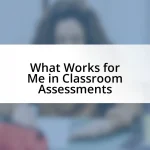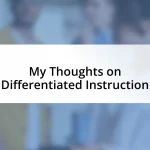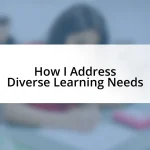Key takeaways:
- Student projects bridge the gap between theory and practice, enhancing critical skills like teamwork, creativity, and problem-solving.
- Collaborative experiences teach the importance of effective communication, adaptability, and the value of shared victories in building lasting relationships.
- Time management skills are developed through juggling deadlines, prioritizing tasks, and implementing regular check-ins for accountability.
- Receiving and applying feedback fosters personal growth, encouraging deeper analysis and the incorporation of diverse perspectives in work.

Importance of Student Projects
Student projects are invaluable because they transform theoretical knowledge into practical experience. I still remember working on a group project in college that forced me to navigate differing opinions and collaborate effectively. Have you ever found yourself in a similar situation? That challenge taught me not just about the subject matter, but also about teamwork and resilience.
Participating in student projects fosters creativity and critical thinking, skills that are crucial in today’s fast-paced world. I recall the thrill of brainstorming ideas late into the night with classmates, leading to a final presentation that felt like our masterpiece. Those moments of creativity ignited a passion for problem-solving that I carry with me today.
Moreover, student projects prepare individuals for the real world by simulating authentic challenges. For instance, I was tasked with developing a marketing plan for a hypothetical product, and it felt exhilarating! Engaging with real-world scenarios allowed me to connect classroom learning with life beyond school walls, making the entire experience feel relevant and impactful. Isn’t it incredible how such projects can shape our future?

Types of Student Projects
Student projects can take many forms, each offering unique learning opportunities. From my experience, these projects can range from research papers to hands-on experiments, engaging students in various ways. The diversity in project types not only caters to different learning styles but also keeps the academic experience fresh and exciting.
Here’s a variety of common student project types that I’ve encountered:
- Group presentations: Collaborating with peers to present a topic, which hones communication skills.
- Research papers: In-depth exploration of subjects that sharpen analytical thinking.
- Artistic projects: Expressing creativity through mediums like painting or digital design.
- Experiments: Hands-on experiences, often in science classes, that bring theories to life.
- Community service: Projects that connect students to their communities, fostering empathy and social awareness.
I distinctly remember one semester when I had to create a documentary for my media studies class. It was exhilarating to research a subject I loved and then piece together interviews, footage, and narration. The whole process felt like a mix of pressure and exhilaration, and I learned so much about storytelling beyond just the facts—incorporating emotions and perspectives that truly resonated with the audience.

Learning from Collaboration Experiences
Collaborative projects have a unique way of exposing the strengths and weaknesses of team dynamics. Once, I was part of a team tackling a presentation for a tough subject. It was eye-opening to see how different perspectives could either lead to explosive debates or creative breakthroughs. This experience taught me that effective communication is crucial. I often remind myself that listening actively and being open to feedback can transform conflict into collaboration.
Working alongside others can also be a lesson in adaptability. During another project, my team had to pivot dramatically when one member moved away unexpectedly. I felt a mix of anxiety and determination as we reassessed our collective strengths. This taught me that flexibility in collaboration doesn’t just mean adjusting timetables but also being willing to embrace new roles. Does that resonate with your own group experiences? From those moments, I learned that compromise and resourcefulness are invaluable skills.
Moreover, shared victories in collaboration are immensely rewarding. I remember the rush of excitement when we finally submitted our project after long hours of brainstorming and revisions. The bond that formed through those late nights and countless cups of coffee built a sense of camaraderie that I still cherish. Celebrating those achievements together made me realize how collaboration can create lasting friendships and a supportive network that extends beyond the classroom.
| Learning from Collaboration | Personal Insights |
|---|---|
| Strength in team dynamics | Effective communication can transform debates into creativity. |
| Adaptability in roles | Adjusting to changes teaches resourcefulness and compromise. |
| Shared victories | Camaraderie from collaborative efforts fosters lasting friendships. |

Developing Time Management Skills
Managing time effectively is something I genuinely developed through various student projects. I remember a particularly frantic week when I juggled multiple deadlines. It was overwhelming, but I realized that creating a daily to-do list helped me visualize my tasks. Have you ever tried that? Breaking things down into manageable chunks made everything feel less daunting, allowing me to focus on one task at a time.
In another instance, I found myself deep in a group project that fell behind schedule. The pressure was palpable as we neared our presentation date. To regain control, we implemented regular team check-ins. These check-ins not only kept us accountable but also fostered a sense of urgency. It struck me how essential it is to have a clear timeline and stick to it. Do you find that setting deadlines boosts your productivity as well?
Reflecting on these experiences, I understand that time management isn’t just about organizing tasks—it’s also about prioritizing them. I learned to assess what truly needed my attention first. One late night, while balancing a research paper and a presentation, I chose to focus on the presentation because it had a stricter deadline. Trust me, embracing that prioritization made all the difference and taught me skills I still use today. How do you decide what to tackle first in your schedule?

Enhancing Research and Writing Skills
When diving into student projects, I quickly learned that rigorous research goes hand in hand with effective writing. I remember the first time I had to sift through dozens of academic articles for a paper. It felt overwhelming, but as I developed a system for summarizing each source, I noticed my confidence increase. Have you ever felt that sense of clarity when organizing complex information? It’s such a rewarding feeling when you transform a mountain of data into cohesive arguments.
Furthermore, crafting my writing became more intuitive as I practiced. I still recall the thrill of receiving feedback on a draft that I thought was solid. The constructive criticism opened my eyes to the importance of clarity and precision in my writing. What I’ve found is that expressing ideas clearly not only engages the readers but also compels them to think critically about the topic at hand. I now approach each writing task with the mindset that every word counts and carries potential impact.
Lastly, the process of peer review taught me a great deal about nuance in writing. I vividly remember reading a classmate’s project and being struck by how their unique voice complemented the subject matter. As I reflected on my own writing, I realized I needed to strike a balance between my style and the academic tone required. This taught me that your authentic voice can shine through even the most formal of topics. Have you ever considered how your personal experiences influence your writing? Embracing that connection ultimately enriches the entire narrative.

Applying Feedback for Improvement
Receiving feedback has been one of the most enlightening aspects of my experience with student projects. I remember racking my brain over a group presentation only to realize later that the feedback we received highlighted areas I hadn’t even considered. It’s almost like discovering a hidden layer to your work, wouldn’t you agree? Taking that feedback to heart not only helped my team refine our ideas but also boosted my confidence in embracing constructive criticism.
One particularly eye-opening moment came when a professor pointed out that my arguments lacked depth. At first, I felt a wave of embarrassment, but as I reflected on their words, I understood that I could deepen my analysis. I dove back into my research and added real-life examples that resonated with the audience. Have you ever experienced a moment where feedback transformed your perspective? That shift in my approach not only improved my project but also taught me to see feedback as a valuable tool for growth.
I’ve found that the key to applying feedback effectively lies in being open and proactive. Once, after presenting a report, I sought additional opinions from peers outside my group. Surprisingly, their insights were incredibly useful. It reminded me that multiple viewpoints can enrich a project immensely. Do you actively seek out various perspectives, or do you stick to what feels comfortable? Embracing diverse feedback has profoundly changed how I refine my work, turning potential weaknesses into strengths.

Real World Applications of Learning
When I think about the real-world applications of learning, I can’t help but recall my experience working on a community project. We identified a local issue—access to fresh produce—and designed a solution that connected residents with local farmers. Seeing our project transform into something that actually made a difference was incredibly fulfilling. Have you ever witnessed your academic efforts blossom into real change? It’s a profound realization of how classroom knowledge can directly impact communities.
In another instance, participating in a mock business competition honed my understanding of market dynamics. I remember drafting a business plan that included a comprehensive marketing strategy. Presenting it to professionals who critiqued our ideas was nerve-wracking but invaluable. Their feedback brought to light the complexities of consumer behavior and competition—concepts I had only skimmed over in textbooks. How often do we dive into theory without grasping its practical implications? This experience solidified my belief that engaging with real-world scenarios enhances conceptual learning.
Lastly, I once collaborated with an environmental group as part of a project focused on sustainable practices. We investigated how schools could reduce waste, and I felt a sense of accomplishment when our recommendations were implemented. It was a testament to how academic insights could guide practical solutions. Have you ever felt that spark of excitement when your knowledge leads to actionable change? It’s moments like these that truly underline the significance of bridging theory with practice.














